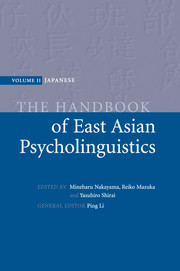Book contents
- Frontmatter
- Contents
- List of figures
- List of contributors
- In memory of Miwa Nishimura
- Preface
- Introduction
- Language acquisition
- 1 Ontogeny of language
- 2 Caregivers' speech
- 3 The intrinsic link between gesture and speech at the prelinguistic stage
- 4 Infant speech perception
- 5 Phonological acquisition
- 6 The mechanism of lexical development: implications from Japanese children's word learning
- 7 The acquisition of nouns and verbs in Japanese
- 8 The acquisition of verbal nouns
- 9 The acquisition of Japanese numeral classifiers
- 10 The acquisition of case markers
- 11 The acquisition of tense and aspect
- 12 On the origin of children's errors: the case of Japanese negation and direct passive
- 13 Binding Theory in UG and first-language acquisition of Japanese
- 14 The acquisition of the particles ne, yo, and no
- 15 The acquisition of linguistic politeness in Japanese
- 16 Children's narrative structures
- 17 Memory talk and testimony in children
- 18 Developmental dyslexia
- 19 Japanese Sign Language
- 20 The role of an innate acquisition device in second-language acquisition
- 21 Japanese, the grammar of reflexives, and second-language acquisition
- 22 Processes in L2 Japanese sentence production
- 23 The development of lexical competence among second-language readers
- 24 Reading in Japanese as a second language
- 25 Intrasentential code-switching in Japanese and English
- Part II Language processing
- References
- Name index
- Subject index
14 - The acquisition of the particles ne, yo, and no
from Language acquisition
Published online by Cambridge University Press: 05 June 2012
- Frontmatter
- Contents
- List of figures
- List of contributors
- In memory of Miwa Nishimura
- Preface
- Introduction
- Language acquisition
- 1 Ontogeny of language
- 2 Caregivers' speech
- 3 The intrinsic link between gesture and speech at the prelinguistic stage
- 4 Infant speech perception
- 5 Phonological acquisition
- 6 The mechanism of lexical development: implications from Japanese children's word learning
- 7 The acquisition of nouns and verbs in Japanese
- 8 The acquisition of verbal nouns
- 9 The acquisition of Japanese numeral classifiers
- 10 The acquisition of case markers
- 11 The acquisition of tense and aspect
- 12 On the origin of children's errors: the case of Japanese negation and direct passive
- 13 Binding Theory in UG and first-language acquisition of Japanese
- 14 The acquisition of the particles ne, yo, and no
- 15 The acquisition of linguistic politeness in Japanese
- 16 Children's narrative structures
- 17 Memory talk and testimony in children
- 18 Developmental dyslexia
- 19 Japanese Sign Language
- 20 The role of an innate acquisition device in second-language acquisition
- 21 Japanese, the grammar of reflexives, and second-language acquisition
- 22 Processes in L2 Japanese sentence production
- 23 The development of lexical competence among second-language readers
- 24 Reading in Japanese as a second language
- 25 Intrasentential code-switching in Japanese and English
- Part II Language processing
- References
- Name index
- Subject index
Summary
Introduction
Japanese has a number of sentence particles, which include both sentence-final particles (shuujoshi) and sentence-internal particles (kantoojoshi). Since sentence particles are not used as content words, they do not carry referential meaning. Typically they occur in face-to-face interaction and index various speech acts. Thus, they are essential in sense making in face-to-face interaction. To become a competent speaker of Japanese, then, it is crucial that young Japanese children acquire and use them appropriately. The social meaning of a sentence particle at least in part emerges from the immediate speech context, so it differs from context to context. For this reason, it is often beyond the limits of the native speakers' conscious awareness. Although there are many sentence particles, in this chapter I discuss three particles, ne, yo, and no, for they occur most frequently in adult conversation (National Language Institute reported in Yamada, 1980) and are the first sentence particles that emerge in children's speech (e.g. Clancy, 1985).
The particles ne and yo have been analyzed in terms of the degree of the speaker's joint access to or possession of information with the addressee (Kamio, 1991; Maynard, 1997). In this analysis, the particle ne is a marker of information shared between the speaker and the addressee, while the particle yo is a marker of information solely claimed by the speaker.
- Type
- Chapter
- Information
- The Handbook of East Asian Psycholinguistics , pp. 103 - 109Publisher: Cambridge University PressPrint publication year: 2006
- 1
- Cited by



